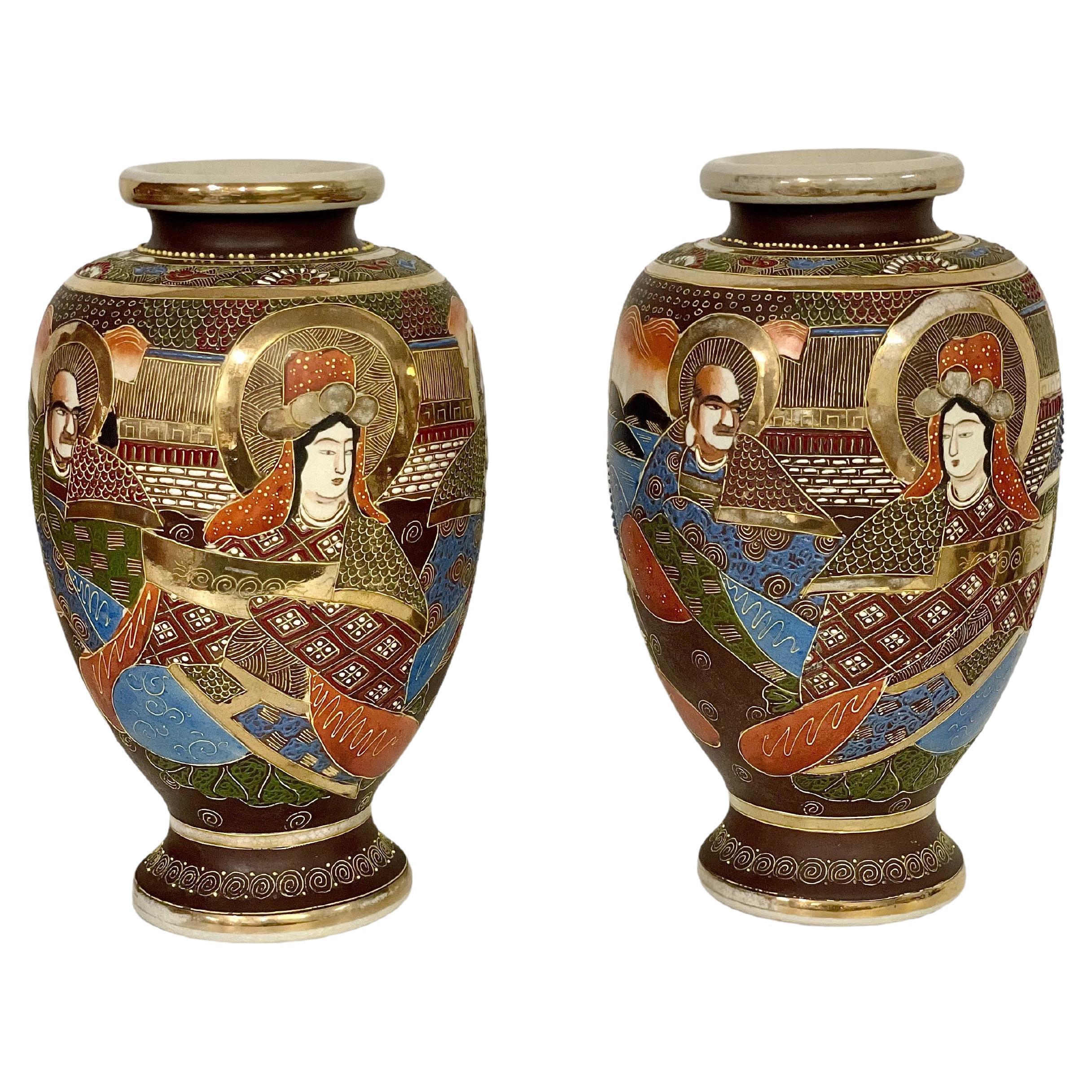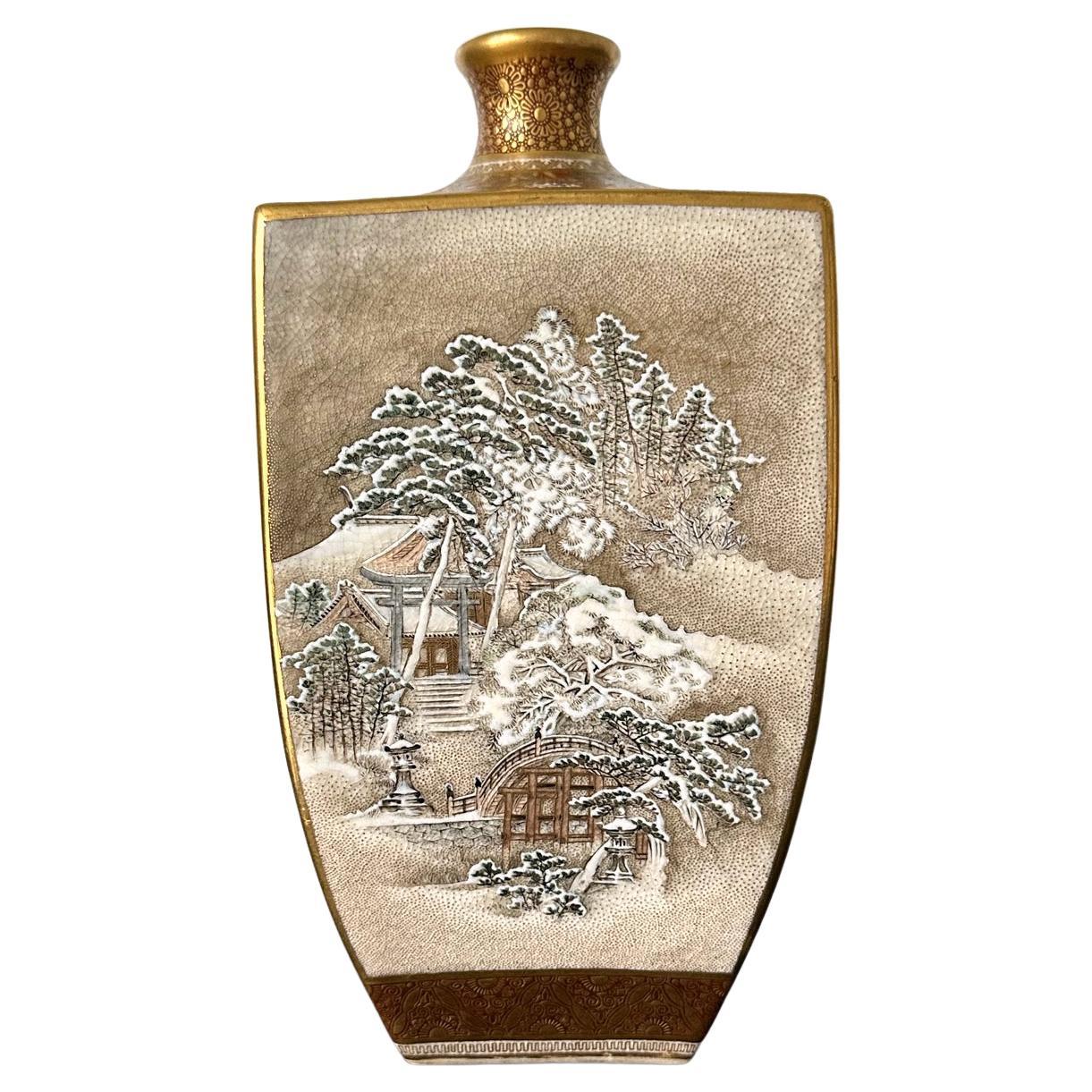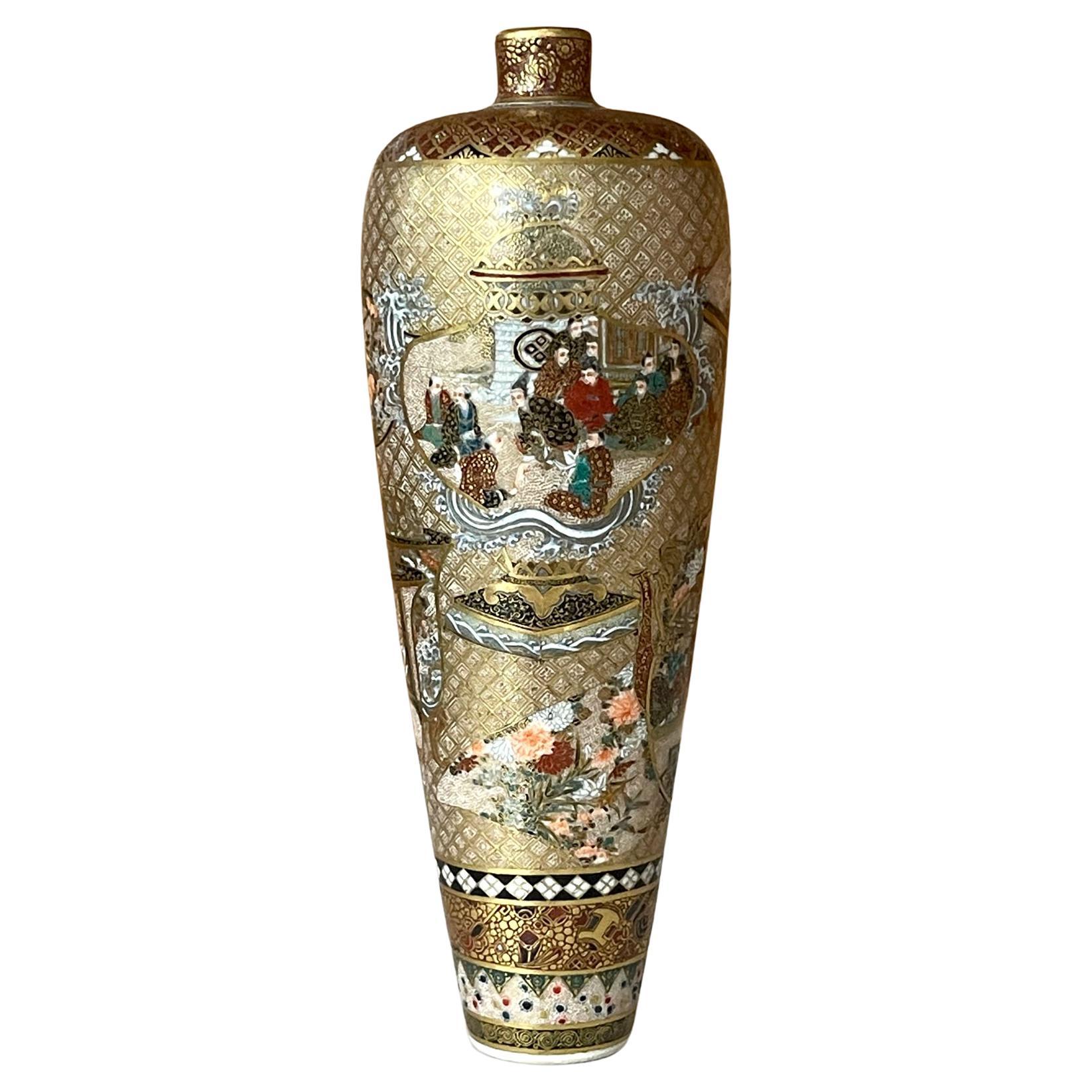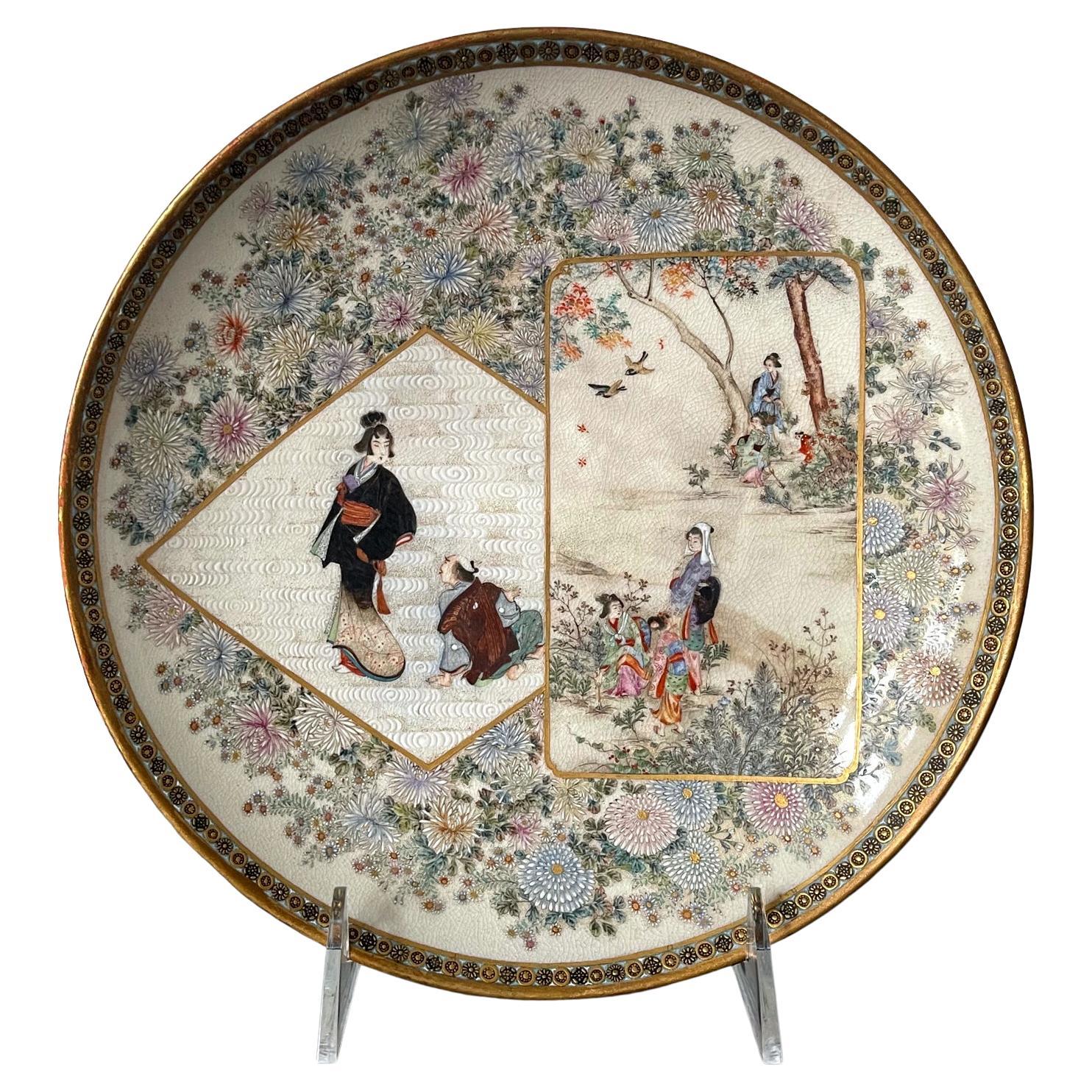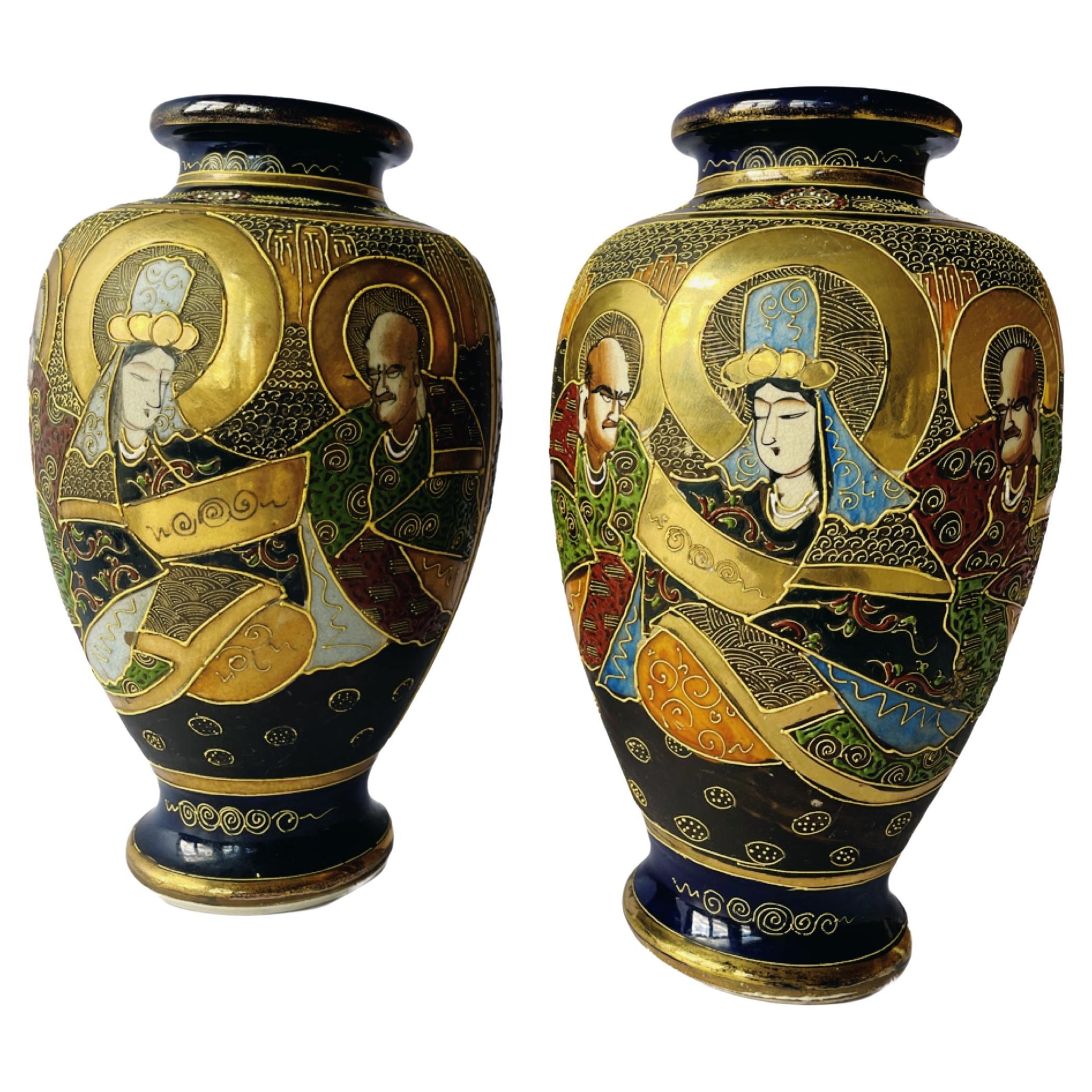Items Similar to Pair of Fine Miniature Satsuma Vase with Moriage Enamel Decoration by Seikozan
Want more images or videos?
Request additional images or videos from the seller
1 of 21
Pair of Fine Miniature Satsuma Vase with Moriage Enamel Decoration by Seikozan
About the Item
A pair of small ceramic vases with superb surface decorations made by Japanese studio Seikozan circa 1890-1910s (late Meiji Period). One of the many artist studios that specialized in satsuma ware, Seikozan was perhaps a handful exceptional establishment in Kobe that produced masterpieces with the highest quality and craftmanship, comparable to the work from the studio of Yabu Meizan. The output was small and most limited to miniature scale with impeccably detailed surface decoration.
The matching satsuma vases form a rare pair, and they feature dense gilt and enamel decoration in a slight moriage fashion. Each vase features two shield-shape vignettes at front and back, surrounded by gilt borders, and in between, partitioned zones of various geometrical and floral motifs in jewel-tone enamels. Each vignette depicts a boisterous scene from various stage of a festival gathering, populated by large numbers of party goers. From the preparing the initial arrival of the guests to welcome the guests at the gate, from arranging foods and drinks to the final lively banquet. The four vignettes form a continuous story board. Densely painted as it was, every character was rendered lively and completely unique, from their attires, postures, gestures, movements, down to the facial expressions, and all ages and genders were included. The dimensional composition and meticulous execution are so impressive that the images impress the viewers as a snapshot of the moment. One can feel the infection of the joyful atmosphere by looking at them.
Both vases were signed on the base "Seikozan". These are miniature masterpieces, pinnacle in workmanship and rarely available as a pair with spatial and temporal pictorial narratives.
- Dimensions:Height: 5.3 in (13.47 cm)Diameter: 3.5 in (8.89 cm)
- Sold As:Set of 2
- Style:Meiji (Of the Period)
- Materials and Techniques:Ceramic,Enameled
- Place of Origin:
- Period:
- Date of Manufacture:1890-1910s
- Condition:Wear consistent with age and use. Fine antique condition with minor shelf wear and very light gilt rubbing around the mouth rim.
- Seller Location:Atlanta, GA
- Reference Number:1stDibs: LU945038418892
About the Seller
5.0
Platinum Seller
These expertly vetted sellers are 1stDibs' most experienced sellers and are rated highest by our customers.
Established in 2006
1stDibs seller since 2010
479 sales on 1stDibs
Typical response time: <1 hour
- ShippingRetrieving quote...Ships From: Atlanta, GA
- Return PolicyA return for this item may be initiated within 2 days of delivery.
More From This SellerView All
- Fine Japanese Satsuma Vase with Superb Decoration by SeikozanLocated in Atlanta, GAA ceramic vase in tapered square form made by Japanese studio Seikozan circa 1890-1910s (late Meiji Period). One of the many artist studios that specialized in satsuma ware, Seikozan...Category
Antique 1880s Japanese Meiji Ceramics
MaterialsCeramic
- Exquisite Japanese Satsuma Vase by SeikozanLocated in Atlanta, GAA miniature vase in elegant upright form reminiscent of the Chinese imperial Willow Leaf form made by Japanese studio Seikozan circa 1890-1910s (late Meiji Period). One of the many a...Category
Antique 1880s Japanese Meiji Ceramics
MaterialsCeramic
- Pair Japanese Satsuma Plates with Miniature Decoration by KinkozanBy KinkozanLocated in Atlanta, GAA pair of Satsuma ceramic plates made by Kinkozan studio circa 1880-1900s during the late Meiji Period. Each dish features miniature enamel decoration o...Category
Antique Late 19th Century Japanese Meiji Ceramics
MaterialsCeramic
- Japanese Satsuma Ceramic Dish with Fine Decoration by KinkozanBy KinkozanLocated in Atlanta, GAA satsuma ceramic dish made by Kinkozan studio circa 1980-1900s in the late Meiji Period. The dish with a thick robust wall is supported by a large ring base and features finely deta...Category
Antique Late 19th Century Japanese Meiji Ceramics
MaterialsCeramic
- Fine Japanese Satsuma Ceramic Jar with Gilt Decoration by KinkozanBy KinkozanLocated in Atlanta, GAA large Japanese ceramic vase from end of Meiji period circa 1880s- 1910s by Kinkozan (1645-1927). One of the largest studio manufacturers of the export ceramics at the time based in Kyoto. In the typical style of satsuma made at the turn of 20th century, the vase is of a moon jar shape and finely decorated with kinran-de (gold paint) on a cream white background with even fine crackles. What sets this particular vase apart from many lower quality and mass-produced pieces is the meticulously renditioned surface decoration. Lavishly gilded with a continuous design, the carefully composed imagery depicts an elaborately decorated float cart in a festival parade. A group of people are seated within the float with a woman and a child standing in the front. Surrounding the float are streams of marchers dressed...Category
Early 20th Century Japanese Meiji Ceramics
MaterialsCeramic
- Fine and Rare Miniature Satsuma Vase by Taizan YoheiLocated in Atlanta, GAA very fine miniature ceramic vase in satsuma ware by Taizan Yohei (1864-1922) circa 1880-1890s of late Meiji period. The vase with a broad flat shoulder ...Category
Antique 1880s Japanese Japonisme Ceramics
MaterialsCeramic
You May Also Like
- Pair of Porcelain Japanese Satsuma 'Moriage' Gilt VasesBy SatsumaLocated in LA CIOTAT, FRThis handsome pair of 20th century glazed and gilded Japanese Satsuma vases, with their vivid, jewel-like colours and elegant baluster-shaped forms, feature the traditional Japanese ...Category
20th Century Japanese Ceramics
MaterialsPorcelain
- Pair of Japanese Moriage Satsuma Vases with Gold Gilding Circa 1930-1940Located in Ixelles, BEJapanese Satsuma vases from the circa 1930-1940 period are a particular style of ceramic art that originated from the Satsuma province of Japan. Satsuma ware is renowned for its intricate hand-painted designs, rich colors, and distinctive crackled glaze. Satsuma ware dates back to the early 17th century, but it gained widespread popularity in the late 19th and early 20th centuries, including the 1930s and 1940s. Satsuma vases produced during this time often reflected a mix of traditional and modern influences, as Japan went through a period of cultural exchange and artistic experimentation. Satsuma vases are made from a type of Japanese earthenware clay known for its fine texture and malleability. The vases are hand-formed or wheel-thrown and then meticulously hand-painted with intricate designs using enamel paints. The distinctive crackled glaze was achieved by firing the vases at a relatively low temperature, allowing the glaze to crack during the cooling process. The moriage technique involves applying three-dimensional, raised ornamentation to the surface of the ceramic piece, creating a visually textured and layered effect. Artisans create three-dimensional patterns, designs, or intricate motifs using a special mixture of clay, slip, or porcelain paste. The raised elements are added by hand to the ceramic body, and each detail is carefully shaped to achieve the desired effect. The moriage is then gold gilded as some of the intricate ornamental patterns and the halos around the three immortal...Category
Early 20th Century Japanese Showa Ceramics
MaterialsPottery
- Antique Japanese Satsuma Miniature Cabinet VaseBy Master RyozanLocated in Philadelphia, PAA fine diminutive, antique Japanese Satsuma pottery cabinet vase. Decorated throughout with gilding and raised enamel. There are...Category
20th Century Japanese Meiji Vases
MaterialsCeramic
- Fine Japanese Satsuma Ceramic Vase by KinkozanBy KinkozanLocated in Christchurch, GBAs part of our Japanese works of art collection we are delighted to offer this finely decorated Meiji Period (1868-1912) Satsuma vase stemming from the highly regarded Kinkozan studi...Category
Antique Late 19th Century Japanese Meiji Ceramics
MaterialsCeramic
- Satsuma Japanese Meiji Miniature Enameled Teapot Kozon MarkBy SatsumaLocated in Bishop's Stortford, HertfordshireAn exceptional Japanese Satsuma miniature spool shaped pottery teapot and cover finely hand enameled with Kozon mark and dating from around 1880. This delightful teapot has an invers...Category
Antique 19th Century Japanese Meiji Ceramics
MaterialsPottery
- Japanese Satsuma Vases, PairBy SatsumaLocated in New York, NYA gorgeous pair of Japanese earthenware Satsuma vases, hand-painted, Meiji period, circa early-20th century, Japan. Vases' beautiful decoration is high-qu...Category
Early 20th Century Japanese Meiji Ceramics
MaterialsEarthenware
Recently Viewed
View AllMore Ways To Browse
Satsuma Moriage
Japanese Satsuma Moriage
Miniature Satsuma Vase
First Half 20th Century Ginger Jars
Republic Period Bats And Peaches Large Vase
Arita Dish
Chinese Bamboo Straw Art
Asian Antiques And Furniture San Francisco
Chinese Nanking Vases
Asian Very Thin Porcelain Bowls
Meiji Hirado Porcelain
Opium Smoke
Porcelain Geisha Figure
Blue And White Censer
Japanese Koinobori Windsock
Wanli Bowl
Antique Bonsai Pot
Bonsai Pot Antique
